VIEW FINDER
By Andrew Maerkle
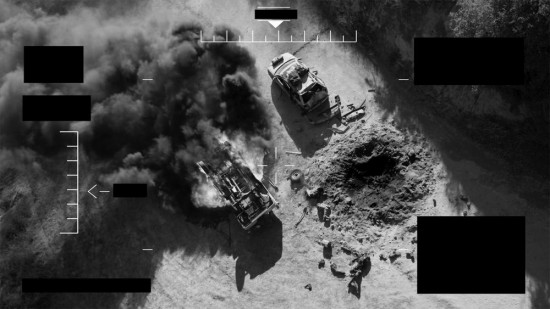
5000 Feet is the Best (2011), single-channel, HD video, color, sound, English spoken, 30 min. All images: Unless otherwise noted, © Omer Fast; courtesy the artist, gb agency, Paris; and Taro Nasu, Tokyo.
Born in 1972 in Jerusalem, and currently based in Berlin, Omer Fast is one of the preeminent artists working in film and media today. His early work, CNN Concatenated (2002), spliced together footage of CNN newscasters, reporters and commentators into an uncanny monologue on life, death and self-abnegation, set against the backdrop of alarmist headlines and info-graphics covering everything from the stock market to the September 11 terrorist attacks and the hunt for Osama bin Laden. The interest in the subtexts of everyday speech and behavior, and the exploration into the susceptibility of photographic media to after-the-fact manipulation seen in this work have remained as prevailing themes in Fast’s practice. In the four-channel film The Casting (2007), for example, an interview with a US Army sergeant, who relates the experiences he had while stationed in Germany and in Iraq, is reenacted by Fast and another actor, and scenes from the soldier’s stories are illustrated through elaborately realistic tableaux vivants–but the internal logic of the stories begins to collapse, and, no matter how real they may first appear, the tableaux vivants are self-consciously artificial. Fast earned further international acclaim for the video 5000 Feet is the Best (2011), which takes as its subject a US military drone sensor operator stationed near Las Vegas. The work proceeds through a series of surreal vignettes that tease out the drone technology’s integration with contemporary moving-image culture–with the aesthetics of the camera itself–and the moral implications of how we respond to and read those images.
Shown at institutions around the world, 5000 Feet was on view recently in Tokyo, alongside the multimedia installation Her Face Was Covered (2011), in Fast’s debut solo exhibition with Taro Nasu gallery, which ran from September 11 to October 10 of this year. ART iT met with Fast prior to the exhibition opening to discuss these and other works, as well as the ideas informing his practice.
I.
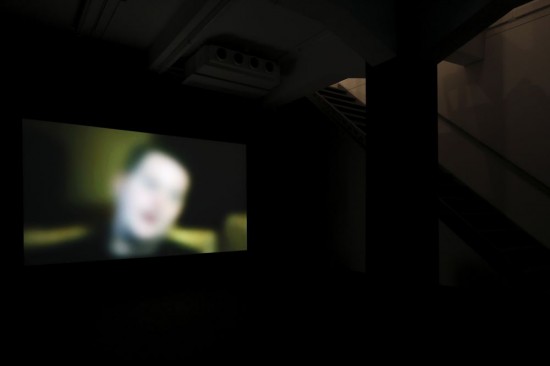
Installation view of 5000 Feet is the Best (2011) at Taro Nasu, Tokyo, 2015. Photo Keizo Kioku. © Omer Fast, courtesy Taro Nasu, Tokyo.
ART iT: Both off-screen, as part of the pre-production process, and on-screen–often in the form of a reenactment–the interview is one of the basic, constitutive units of your works. Could you explain how you approach the interview, both in terms of developing your works, and also as a form that signifies something in and of itself?
OF: There’s an implicit voyeurism to meeting strangers and speaking to them about their lives. I think of myself as a voyeur and a parasite. I use the bodies of others, and their lives and stories, to create my works. I attach myself to people for as long as it takes to suck out their stories and come away with the material from which a work can be created. That said, of course the subjects of the works are not completely random. I seek out people who are related to specific situations that interest me. As for the process, you contact the subject, whether directly or through some institution or organization, and arrange for meetings if possible.
ART iT: But the interview seems like a relatively recent phenomenon within the entire history of recorded human discourse, in the sense that there’s a democratic aspect to it–the idea that you can get the real story from speaking to another individual one-to-one–that probably wasn’t there in a rigidly hierarchical feudal society.
OF: I’m not sure that it is entirely democratic, because there are power dynamics implicit in any encounter–very much so in an interview where someone wants to get information from another person. In the feudal context in the West, for example, the analog might be the church, the confessional, or the Inquisition, which gleaned information from people, but very much with power dynamics defining the encounter. Maybe these dynamics are a bit more vague in what I do, because as an artist I do not have an obvious power structure behind me. But if you scratch the surface, of course it’s there. My works are shown institutionally, they are financed by institutions with particular interests, and they are shown to a public that has very little to do with the people I meet and interview for the works. So I wouldn’t congratulate myself for doing something that is democratic. I think what I’m trying to do, maybe as a corrective, is to play around with those power dynamics, and to include my own sense of what they are in the work–even if they were not explicit in the actual encounter that I had with the person I interviewed.
ART iT: In the works in which you insert a proxy for yourself as interviewer, there tends to be an antagonistic tension between the interviewer and the interview subject. Is this reflective of what actually happens in the interviews?
OF: Yes and no. I use the encounter and conversation with the subject as a means for gathering material. Then I read through the material, I think about it, and I develop my own fantasies and ideas about what was happening, what could be happening, what should be happening. Very often it’s a correction that results in changes to the text. I try to layer the changes in such a way that some kind of archaeology is possible for the viewer. There are indications that the work isn’t exactly a fly-on-the-wall documentary, or that it is not pretending to be giving an unmediated truth–whatever that is.
In my meetings with the drone sensor operator for 5000 Feet is the Best (2011), the two or three days we met were very much characterized by reticence or reluctance on the part of the interviewee–not so much antagonism, but not so far from that either. Of course, there is a defensiveness that can translate into aggression, and in fact did, by way of him asking me to stop the interview, or saying it’s over, or getting up and leaving the room, leading to my having to run after him and cajole him to come back, or loosen him up.
But the bottom line is that there is a mutual interest on both sides. I have my own agenda, and the people with whom I speak certainly have interests and reasons for agreeing to meet with me. The contract we have between us is usually discussed in the preamble leading toward the actual meeting, but for good and for bad these things are often left out of the actual conversation. Part of my tactic is to bring those aspects back into the work so you’re not just looking at this person as a funnel for information about something interesting happening in the world. It makes you think about the conditions that would bring the filmmaker, the artist, the interviewer, the therapist, the person with the power in that regard–whoever it is–to ask questions of the subject and get information from him or her. By extension, it also makes you think about your own position vis-à-vis these dynamics.
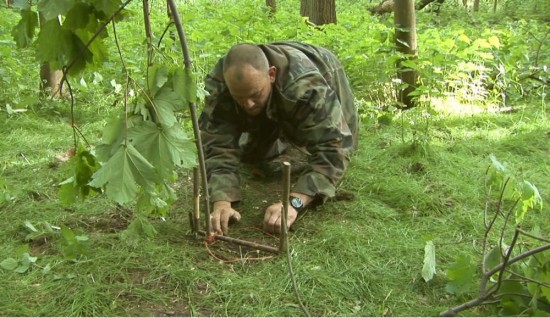
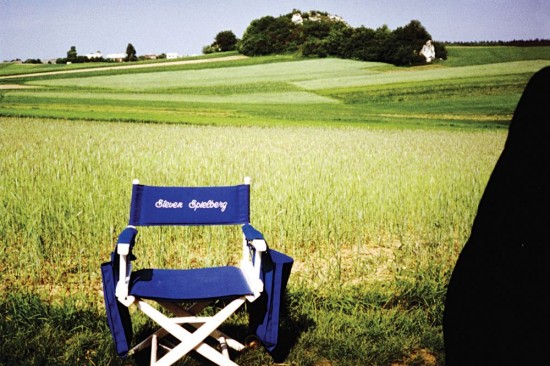
Above: Production photo for Nostalgia (2009). Below: Spielberg’s List (2003): Photo taken by extras during production of the film Schindler’s List, 1993. Both: Courtesy Omer Fast.
ART iT: One work where I feel you do explicitly deal with those issues is Nostalgia (2009). The interviewer or “Omer” character comes across as being well intentioned but yet unable to connect with the interview subject. The relationship becomes increasingly exploitative, as the interviewer seems to lose interest in communicating and just wants to figure out how to shoot the trap-making scene. Was that something you intentionally structured into the work?
OF: While looking for material for this work, I met with quite a few people, speaking with them and recording their stories about migration, their reasons for leaving home and their present situation as asylum seekers in a foreign country. As I was doing this, I began feeling that what I was doing was unethical, that I was in no position to be asking questions of these people, that I wouldn’t be of any help to them–in short, that there was no sense at all to what I was doing. That might be slightly overstating things, but the feelings were there. When you have these meetings with people, certain windows open up, certain rabbit holes that give you an insight into what you’re doing, which often challenges the very activity in which you are engaged. I knew I wanted to channel my doubts about what I was doing into the work, and the “proxies,” as you call them–which is a very good word, because they are doubles and, indeed, proxies for myself–evolved into characters just as much as the people with whom I spoke.
ART iT: As I understand it, in most of your works there’s usually a distancing effect, whereby you have an actual interview that is then reinterpreted by actors or at least in an actorly way. There is an intentional subversion of the “realness” of the interview. On the other hand, watching Spielberg’s List (2003) brings to mind Claude Lanzmann’s Shoah (1985), in which the interviews were very much driven by the ideas of witnessing and of testimony–of recovering the truth–but also ended up getting aestheticized within the film itself. In fact, the aestheticization was perhaps essential to Lanzmann’s recovery of the “truth.” Was that on your mind when you made Spielberg’s List?
OF: I tend to approach my subject matter with a strong interest in finding figures who can reflect on events from both an insider and an outsider’s perspective. Spielberg’s List actually originated from a simple desire to go to Poland, which is where my father’s family comes from, for the first time. I grew up with these people and their stories, but knew I wasn’t interested in looking for “pure” eyewitnesses for my work, whatever that means. As is the case for all of us, my own sense of history is highly informed and even contaminated by media, and for me it made a lot of sense to approach the landscape and the people, and of course the history, vis-à-vis their mediation in popular culture. As such, the work is trying to address both the primary historical event and its representation, which itself has now become its own historical moment.
But beyond that, I think all the subjects in my work share this liminal status. That’s why I’m interested in migrants and soldiers. These are people who are either endowed with special powers or who by circumstance must have recourse to crossing borders, to trespassing. For example, the man from 5000 Feet is very much a late incarnation of our notion of what a soldier is. He’s not a heroic Ulysses who packs into a ship, sails off, and returns a changed man, having wreaked havoc in his path. I was instead interested in the ambiguities and the paradox that technology now bears on that figure of the warrior as someone to whom the state grants the power to trespass, to go into another terrain and enact the will of a particular government. In the case of the drone operator, the contradiction that has been created by his job, and the technology that his job involves, means that he never even has to leave home in order to engage in combat far away. He simply drives to work and sits in front of a computer in an office, just like we do.
ART iT: Is it this interest in liminal figures that led you to explore the idea of nested narratives, and nested voices, in your works?
OF: I think it very much has to do with that. Biographically speaking, I don’t have a very stable sense of identity or origin. I had an early awareness of how much one’s identity, both collectively and individually, involves a particular code and performance, so for me this notion of looking at something from both the inside and outside is very critical. Structurally, this multiple or split perspective translates into narratives that distrust the firsthand account–the speaker who will convey something in an unmediated fashion–and tend to favor what you call “nested” narratives, but could also be described as fractured, fragmented and multivalent narratives.
So there is something of a biographical rationale to it, but since the media permeates so much of what constitutes experience for us, it’s very difficult to think about something–for me at least–without thinking immediately about the codes that are being used to represent and articulate it. Maybe it can get overbearing, but I’m just not comfortable turning on a camera and asking somebody questions and then coming home and making the best possible edit of that. There has to be a consideration of what that encounter was about and some kind of distancing, parallel, or even metaphorical structure around that.
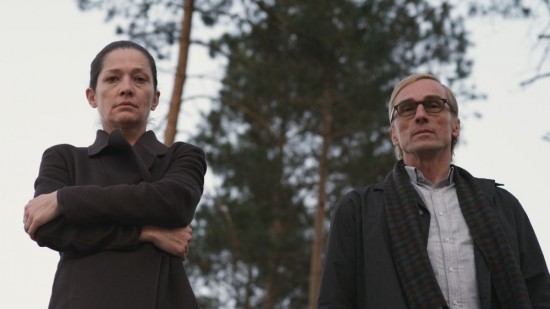
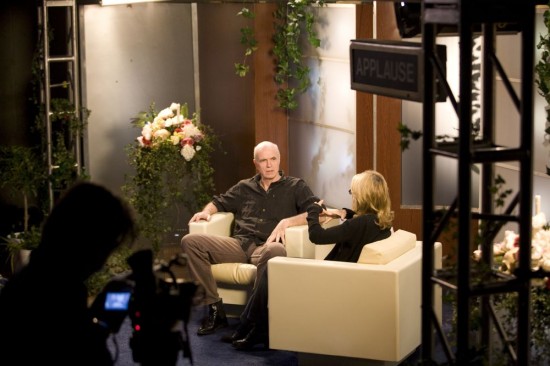
Above: Continuity (2012), single-channel, HD video, color, sound, 40 min loop. Image Philip Wölke. Courtesy Omer Fast, gb agency, Paris; Arratia, Beer, Berlin; and Dvir Gallery, Tel Aviv. Below: Talk Show (2009), a Performa Commission, co-produced by Artis Contemporary Israeli Art Fund, Edith Russ House for Media Arts, Oldenburg, and the Goethe-Institut, Hong Kong. Photo Olimpia Dior.
ART iT: In that sense the more explicitly fictional works, like De Grote Boodschap (2007) and Continuity (2012), are interesting because they have a distinct cannibalistic energy to them: both in terms of the formal structure of one story “eating” another, and in their representation of familial relationships.
OF: I agree.
ART iT: The idea of role-playing, or playing to the camera, also seems to be an important part of your work. In Nostalgia, the interview subject starts changing his story in response to what he thinks the interviewer wants. In Continuity, each “son” tries to understand what is expected of him by the “mother” and “father”–with the intimation that their lives may depend on it. In Talk Show (2009), too, the actors must improvisationally reinterpret a personal story they are hearing for the first time, but whenever they can’t recall the details of the story, they embellish it with the lurid things they expect a typical talk show guest might say, which are in fact inconsistent with the tone of the actual story.
OF: As I said, my notion of identity is very much premised on performance. What the work tries to do is to examine the performative aspect of being an individual within a particular culture, and the perverse relations that emerge when certain codes are examined or altered. Continuity was commissioned by a television broadcaster, so I started to think about a middle-class melodrama and the notion of homecoming: What has our son done? Where has he been? I thought it would be interesting to create what initially seems to be a credible family unit, while slowly planting hints that it is anything but. I wanted to see how far I could push that story so that it transforms into a theatrical play about characters performing a family. You understand that these characters are conveying a life, and yet you know that each one of them at any point in the film is playing a role too, whether it’s the case of husband or father, mother or wife, and, most critically, that of the son, who’s lodged between the parent figures and has no fucking clue what he’s supposed to do. So he tries to adapt, and we watch him.
And you’re right, that’s exactly the dynamic that happened with Talk Show. In the way I conceived the performance, the audience were the gods on Olympus, sitting in their elevated seats above the stage and watching the humans below struggling to make sense of things. Somebody tells a story to an actress. When it’s done, she retells it to another actor, who was unable to hear the story until coming onto the stage. The actor must then repeat the story to another, without compressing the amount of time it takes to retell it. The audience members know what the story is, and they know that the actors don’t know it. There is a game that happens over several retellings, and the story inevitably mutates.
The work has to be playful about its transparency and what it allows the audience to know. But it’s important that these layers and tricks and the roles that are being played are not being done for the sake of obscuring someone’s identity, but rather in order to literally examine it from several different perspectives.
Omer Fast: View Finder
